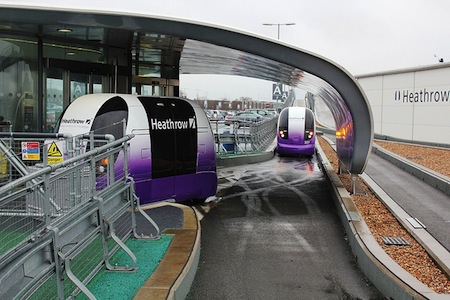Numerous PRT systems have been proposed but only a handful are as yet operational, one of which is the 21-vehicle ULTra system at London Heathrow Airport’s T5. ULTra pods run on rubber tyres, like funfair “dodgems”, and move rather slowly in narrow open guideways with low walls to keep the pods in place. Since the pods use batteries rather than power from the track, the system has clearly been built “on the cheap” and is not as futuristic or innovative as it appears to be.

Personal rapid transit (PRT), aka “podcars”, is a mode of public transport using small automated vehicles operating on a network of guideways. PRT pods are designed for individuals or couples or up to 4 per per vehicle. Guideways are arranged in a network topology with stations located on sidings with merge/diverge points, thus allowing nonstop point-to-point travel, bypassing all intermediate stations. A driverless point-to-point transport mode is akin to an elevator, except it travels in a horizontal direction.
Mass transit systems are designed to move large numbers of unrelated people over scheduled routes. This has inherent inefficiencies. Passengers waste their time waiting for the next vehicle to arrive and then waste more time at numerous bus stops/stations en-route. Routes tend to be indirect, and schedules confusing or inconsistent. Constantly stopping and starting huge weighty vehicles like buses or trams uses a lot of energy, thus undermining the environmental benefit of public transport.
Personal rapid transit systems attempt to eliminate these wastes by moving small groups nonstop in automated vehicles on fixed tracks. Passengers can usually board a pod immediately upon arriving at a station, and can take relatively direct routes to their destination without stopping. The low weight of PRT’s small vehicles allows much smaller guideways and support structures than mass transit systems like light rail. Smaller structures mean smaller construction costs and less visually obtrusive infrastructure. However, as of now, a citywide deployment with many lines and closely spaced stations, as envisioned by proponents, has yet to be constructed.
[stextbox id=”info”]”SkyTran pods carry just 2 people which keeps the weight down and the track small. This makes sense, as most cars also carry only 1 or 2 people. Pods are easy to access as they come down to ground level at stations. You merely tell the pod your destination after which it moves off to re-join the main rail and then automatically guides you to your destination with no stops or interchanges. At your destination, the pod diverts onto an off-track and drops down a ramp to your stop. Since you are now off the main track, all other pods can pass without needing to slow or stop. Your pod is now ready for the next passengers. Should there be a peak demand elsewhere on the system, empty pods can automatically go to where they are needed. Pods need no timetables: just get in one and go when you are ready, or call one via a mobile phone if one is not waiting. Being driverless, like lifts, they can operate on a 24/7 basis. A pod system would cost much less than a tram system, due to the high cost of the foundations needed for tram tracks. Pod rails are suspended from poles, or even ceilings, so expensive foundations are unnecessary.”
edited from Canberra Times, July 6th 2015.
[stextbox id=’info’ caption=’OA-City clusters’]OA-City habitats may be built in clusters with a larger central module housing most of the employment opportunities, like a busy town/city centre. In this scenario many people might prefer to live in one of the quieter satellite modules and work in the central one. “Commuters” would have a choice of either a 20 minute walk to work or a 2 minute zip in a PRT “pod”.

